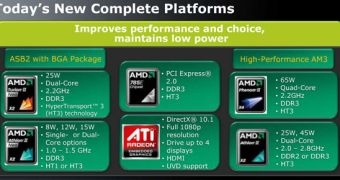Even though AMD is lagging behind Intel in terms of consumer and mobile PC processors, the company seems to, at least, be doing well on the embedded market, now that it has completed its latest platform family. Taking advantage of the opportunity provided by the Embedded Systems Conference, the Sunnyvale, California-based CPU and GPU maker showed off the compact ASB2 platform and the high-performance AM3 one.
The two new platforms are based on a combination between the 785E northbridge and the SB710 or SB8x0 southbridge. They are meant to be used in digital signage, POS, networking and other such applications, where they will bring the benefit of support for dual-channel DDR3 memory and a 74% improvement in per-Watt performance.
That said, the most important factor is the power efficiency that these platforms allow without impacting on performance. They do not only support the HyperTransport 3.0 technology, but they also boast the Radeon HD 4200 integrated graphics and have a high reliability and low z-weight, as well as low-cost manufacturing, thanks to their BGA package. As for processor compatibility, the ASB2 and AM3 support single-core, dual-core, triple-core and quad-core CPUs with a maximum TDPs of 65W (and clocks of up to 2.8GHz), or as low as 8W. Consumers interested in further details will, of course, find all the information they need on the official website.
"The barriers to widespread adoption of x86 in the broad embedded market have traditionally been a combination of power, price and the physical footprint of the silicon," Buddy Broeker, director, Embedded Solutions Division, AMD, said. "AMD's embedded solutions have been steadily driving down those barriers while adding enterprise-class performance and features that may not have been readily available to designers in the past. Our commitment to the embedded market grows stronger as we look to a future introduction of AMD Fusion technology products into the embedded space."

 14 DAY TRIAL //
14 DAY TRIAL //